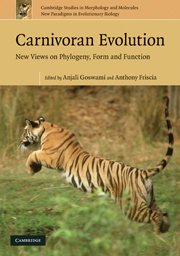Book contents
- Frontmatter
- Contents
- Contributors
- Preface
- Acknowledgements
- 1 Introduction to Carnivora
- 2 Phylogeny of the Carnivora and Carnivoramorpha, and the use of the fossil record to enhance understanding of evolutionary transformations
- 3 Phylogeny of the Viverridae and ‘Viverrid-like’ feliforms
- 4 Molecular and morphological evidence for Ailuridae and a review of its genera
- 5 The influence of character correlations on phylogenetic analyses: a case study of the carnivoran cranium
- 6 What's the difference? A multiphasic allometric analysis of fossil and living lions
- 7 Evolution in Carnivora: identifying a morphological bias
- 8 The biogeography of carnivore ecomorphology
- 9 Comparative ecomorphology and biogeography of Herpestidae and Viverridae (Carnivora) in Africa and Asia
- 10 Ecomorphological analysis of carnivore guilds in the Eocene through Miocene of Laurasia
- 11 Ecomorphology of North American Eocene carnivores: evidence for competition between Carnivorans and Creodonts
- 12 Morphometric analysis of cranial morphology in pinnipeds (Mammalia, Carnivora): convergence, ecology, ontogeny, and dimorphism
- 13 Tiptoeing through the trophics: geographic variation in carnivoran locomotor ecomorphology in relation to environment
- 14 Interpreting sabretooth cat (Carnivora; Felidae; Machairodontinae) postcranial morphology in light of scaling patterns in felids
- 15 Cranial mechanics of mammalian carnivores: recent advances using a finite element approach
- Index
- Plates
- References
8 - The biogeography of carnivore ecomorphology
Published online by Cambridge University Press: 05 July 2014
- Frontmatter
- Contents
- Contributors
- Preface
- Acknowledgements
- 1 Introduction to Carnivora
- 2 Phylogeny of the Carnivora and Carnivoramorpha, and the use of the fossil record to enhance understanding of evolutionary transformations
- 3 Phylogeny of the Viverridae and ‘Viverrid-like’ feliforms
- 4 Molecular and morphological evidence for Ailuridae and a review of its genera
- 5 The influence of character correlations on phylogenetic analyses: a case study of the carnivoran cranium
- 6 What's the difference? A multiphasic allometric analysis of fossil and living lions
- 7 Evolution in Carnivora: identifying a morphological bias
- 8 The biogeography of carnivore ecomorphology
- 9 Comparative ecomorphology and biogeography of Herpestidae and Viverridae (Carnivora) in Africa and Asia
- 10 Ecomorphological analysis of carnivore guilds in the Eocene through Miocene of Laurasia
- 11 Ecomorphology of North American Eocene carnivores: evidence for competition between Carnivorans and Creodonts
- 12 Morphometric analysis of cranial morphology in pinnipeds (Mammalia, Carnivora): convergence, ecology, ontogeny, and dimorphism
- 13 Tiptoeing through the trophics: geographic variation in carnivoran locomotor ecomorphology in relation to environment
- 14 Interpreting sabretooth cat (Carnivora; Felidae; Machairodontinae) postcranial morphology in light of scaling patterns in felids
- 15 Cranial mechanics of mammalian carnivores: recent advances using a finite element approach
- Index
- Plates
- References
Summary
Introduction
Traditional studies of biodiversity are mainly concerned with patterns of taxonomic richness. In neontology, particularly conservation biology, the focus is generally at the species level (Reid, 1998; Mittermeier et al., 2005), while in paleontology, the genus and family levels are often used as proxies (Sepkoski, 1988; Bambach et al., 2004). However, there are of course other aspects to diversity, including genetic diversity (e.g. Petit et al., 2003) and phylogenetic diversity (Faith, 1992). A further type of diversity that has generated some interest over the past decade or so is morphological diversity, often referred to as disparity (Gould, 1991; Foote, 1997). This kind of diversity, which, importantly, does not necessarily covary with richness measures, takes as its study the variation in morphology or morphological types in a study group at a particular time or place. The focal level is generally a higher taxonomic category, such as a Family or Order, but can also be a non-monophyletic adaptive category such as carnivore or herbivore, as the object is not in the first instance to trace the evolution of a specific clade, but to investigate the range of adaptations realised by a group of organisms in a particular setting, or, in other words, the totality of their context-specific ecomorphology.
Such studies of ecomorphology can be used to investigate differences in ecological structure in time and space and help differentiate between processes such as selective or random extinctions. It leads to a much fuller depiction of biological diversity than richness alone. Ecomorphology and analysis of disparity has been used at various scales to study the diversification of vertebrates (Van Valkenburgh, 1989, 1994; Jernvall et al., 1996; Werdelin, 1996; Wesley-Hunt, 2005), invertebrates (Foote, 1994, 1997; Wills et al., 1994; Wills, 1998; Roy et al., 2001), and plants (Lupia, 1999) over their evolutionary history.
- Type
- Chapter
- Information
- Carnivoran EvolutionNew Views on Phylogeny, Form and Function, pp. 225 - 245Publisher: Cambridge University PressPrint publication year: 2010
References
- 14
- Cited by

